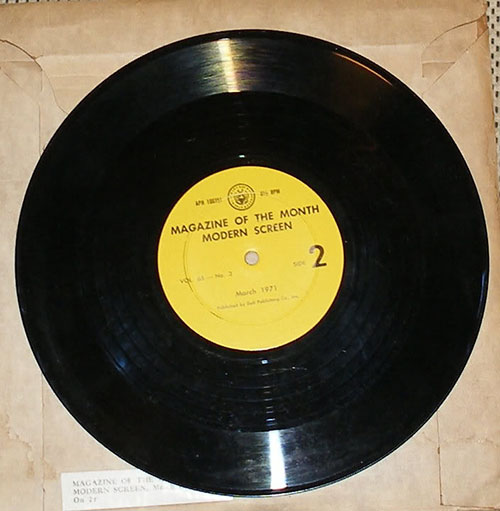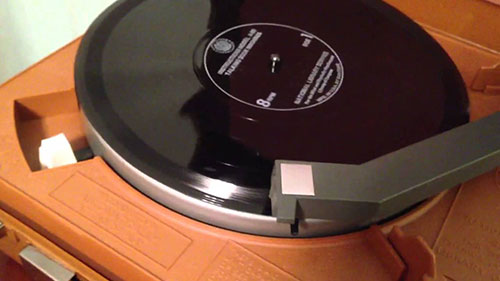Books on Vinyl
Audiobooks are common these days, but advocates for those with vision disabilities saw their value early—as well as the value of the vinyl record.
$100k

The technical considerations of early audiobooks
The strategy that eventually went into use in creating some of the earliest audiobooks is best explained through a couple of different forms of media technology that you might be more familiar with. Here goes:
If you're willing to lose quality, you gain space. If you went to Blockbuster back in the day, odds are generally pretty good that you'd rent a tape that's around two hours long. But if you went to your local Radio Shack, you'd find video tape that would let you record for hours at a time. Those tapes are still available, and can hold up to 12 hours of material. But the thing you give up for that extra length is quality. Fragmenting, for example, is incredibly common, as is visual noise.
Sometimes, lower sound quality is OK. For example, FM radio is clearly better in every way than AM radio, and relies on the improved bandwidth to bring high-quality music to your car. But that AM bandwidth still comes in handy for certain uses that don't need such fidelity—you don't need FM quality to make out the thoughts of Rush Limbaugh or Art Bell. And going even further, Shortwave radio has even lower quality—but gains massive reach. It's all give and take.
Vinyl records came in different speeds. Different records play at revolutions per minute, or RPM, which allows the audio to take up differing amounts of space. And records didn't always follow the traditional formats that you might find in stores, which these days usually come in 12-inch 33⅓ RPM albums and 7-inch 45 RPM singles. During the 1930s and 1940s, for example, radio stations would syndicate shows using gigantic 16-inch vinyl records called transcription discs. (They're pretty rare, but they pop up on YouTube occasionally.)
Finally, vinyl is quirky and endlessly fascinating. There's a vinyl-head phenomenon that's cropped up over the past decade where people take 45 RPM records and slow them down to 33⅓ RPM, which turns Dolly Parton's classic "Jolene" into a Ray Lamontagne song and Michael Jackson into Luther Vandross. (It also works the other way, as well—I can't find a clip on YouTube to prove this, but speeding up The Beatles' "Let it Be" from 33⅓ RPM to 45 RPM basically turns it into a lost Jackson 5 song.) For people of a certain mindset, this is like the coolest rabbit hole ever.
In their own small ways, ideas driving each of the above concepts apply to the earliest audiobooks.

How “Talking Books” got vinyl records spinning
The Library of Congress, with the help of the American Foundation for the Blind (AFB), borrowed from many of the concepts mentioned above in building the technology that became "Talking Book Records."
In fact, the earliest format that went into general use was a 12-inch, 33⅓ RPM vinyl record, very similar to the kind you can find at Urban Outfitters today. Vision-impaired readers were among the first to use this format, at a time when the public was still living life at 78 RPM.
How did the American Foundation for the Blind get their hands on vinyl at a time when everyone else was still using fragile shellac? Credit AFB for doing its due diligence and keeping its eyes on new technologies to make audiobooks feasible from a cost perspective. In 1927, the foundation reached out Frank L. Dyer, a onetime associate of Thomas Edison who had recently patented a process for creating high-capacity "talking machine records."
These records were roughly album-length—30 minutes per side—but the quality of the sound produced was closer to talk radio than music. In other words, it was perfect for books.
By getting Dyer interested in the project early, AFB and the Library of Congress were able to take advantage of his patents on a royalty-free basis. By 1935, the federal government—working with more than $200,000 in funding allotted to the Works Progress Administration (WPA)—started producing 5,000 talking-book machines, which allowed vision-impaired people to listen to audiobooks, often at a library.
The machines were a particularly important part of the equation due to the fact that 33⅓ RPM record players didn't become common until after WWII.
These days, 12-inch vinyl records—which later got past their technical weaknesses and are now considered to have masterful sound—are associated more closely with the Beatles and the heady years of rock 'n' roll than they are with audiobooks, and audiobooks themselves became more closely affiliated with the cassette tape thanks to the 1975 founding of Books on Tape, but the efforts of AFB and the Library of Congress to ensure vision-impaired people have the opportunity to read kept record players and vinyl records specifically in production all the way up to the 1990s.
The era of smartphones and CDs may have changed the format, but it hasn't stopped the mission. The Library of Congress' National Library Service for the Blind and Physically Handicapped remains active to this day—with AFB's help still strong.
16⅔
8⅓
Perhaps the most surprising part about the creation of vinyl audiobooks for blind audiences is the fact that there was a very prominent early critic of this approach: Helen Keller, The Miracle Worker herself.
Keller, a groundbreaking deaf and blind woman who worked with AFB for more than four decades, was not immediately convinced that the foundation should be working on audiobooks or even transcribed books in Braille, arguing her point in economic terms: During a time when people are struggling to find work, why should the foundation put so much energy into a purely educational effort?
"Will radios and talking-books take the place of food, shelter and clothing? Naturally I am not willing to divert the attention of the public to talking-books while more urgent needs of the sightless demand first service," Keller wrote to a friend in February 1935.
That skepticism in the end didn't stop her from taking a key role in its launch. Eventually she decided to change her mind on opposing the project, realizing she could be a roadblock in its success within the organization, and became a key advocate for it in front of both Congress and the President Roosevelt. Her book Midstream was even used as a technology sample.
In September of 1935, Roosevelt signed an executive order funding the Talking Books project—and putting AFB in charge of it.
Keller was ambivalent toward the final result, especially as it didn't benefit her personally because she was deaf, but she knew when it was time to help.
:format(jpeg)/2018/01/hhbu2uwnp02pfipummkx--1-.gif)
/2018/01/hhbu2uwnp02pfipummkx--1-.gif)

/uploads/ernie_crop.jpg)